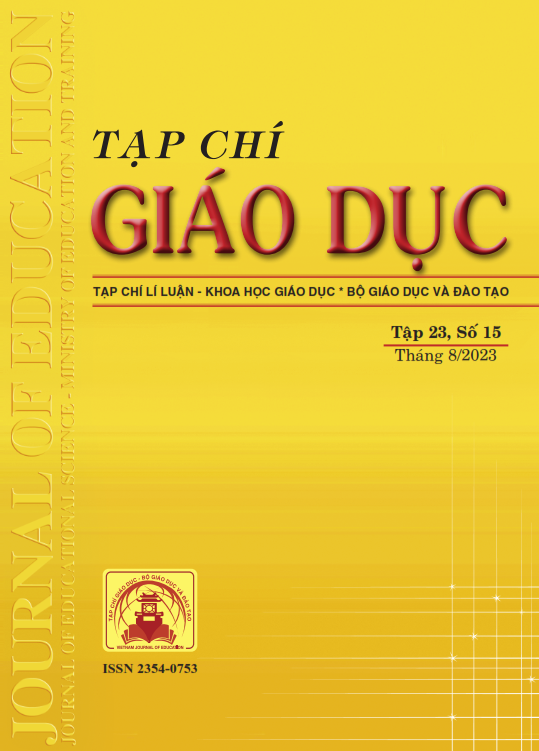Suy luận không gian của học sinh lớp 9 về các biểu diễn hai chiều trong hình lập phương
Tóm tắt
The study was conducted with 50 grade 9 students, using 8 questions related to the vertex and the side length of the cube to evaluate the students' spatial reasoning about two-dimensional representations, focusing on spatial analysis reasoning and spatial visualization reasoning. The spatial reasoning shown in the students' answers was quantified in the study. The results show that the students' spatial reasoning was above average but not high. The proportion of students answering based on visual observations was still high. Most students used spatial analysis reasoning or a combination of spatial visualization and spatial analysis reasoning, but rarely used only spatial visualization reasoning to solve. Students' reasoning about individual vertex or line segments is better than reasoning about problems that combine both.
Tài liệu tham khảo
Battista, M. T. (2007). The development of geometric and spatial thinking. In: F. Lester (Ed.), Second Handbook of Research on Mathematics Teaching and Learning (pp. 843-908). Charlotte, NC: NCTM/Information Age Publishing. Battista.
Clements, D. H., Battista, M. (1992). Geometry and spatial reasoning. In D. A. Grouws (Ed.), Hanbook of research on methematics teaching and learning (pp, 420-464). New York: Macmillan.
Duval, R. (1998). Geometry from a cognitive point of view. In C. Mammana & V. Vallani (Eds.), Perspectives on the teaching of geometry for the 21st centery: An ICMI study. Dordrecht: Kluwer.
Duval, R. (2017). In M. Tania & M. Campos (Eds.), Understanding the mathematical way of thinking: the registers of semiotic representations. Cham: Springer.
Fujita, T., Kondo, Y., Kumakura, H., & Kunimune, S. (2017). Students’ geometric thinking with cube representations: assessment framework and empirical evidence. The Journal of Mathematical Behavior, 46, 96-111. https://doi.org/10.1016/j.jmathb.2017.03.003
Fujita, T., Kondo, Y., Kumakura, H., Kunimune, S., & Jones, K. (2020). Spatial reasoning skills about 2D representations of 3D geometrical shapes in grades 4 to 9. Mathematics Education Research Journal, 32, 235-255. https://doi.org/10.1007/s13394-020-00335-w
Gutierrez, A., Lawrie, C., & Pegg, J. (2004) Characterization of students' reasoning and proof abilities in 3- dimensional geometry. In M. J. Hoines, & A. B. Fuglestad (Eds.), Proceedings of the 28th conference of the International group for the Psychology of Mathematics Education, vol. 2 (pp. 511-518).
Hegarty, M. (2010). Components of spatial intelligence. In Psychology of learning and motivation (Vol. 52, pp. 265-297). Academic Press.
Lowrie, T. (2012). Visual and spatial reasoning: the changing form of mathematics representation and communication. In B. Kaur & T. L. Toh (Eds.), Reasoning, communication and connections in mathematics: Yearbook 2012, Association of Mathematics Educators (pp. 149-168). Singapore: World Scientific.
Lowrie, T., Logan, T., Harris, D., & Hegarty, M. (2018). The impact of an intervention program on students’ spatial reasoning: Student engagement through mathematics-enhanced learning activities. Cognitive Research: Principles and Implications, 3(50), 1-10. https://doi.org/10.1186/s41235-018-0147-y
Mesquita, A. L. (1998). On conceptual obstacles linked with external representations in geometry. Journal of Mathematical Behavior, 17(2), 183-195. https://doi.org/10.1016/s0364-0213(99)80058-5
Mulligan, J., Woolcott, G., Mitchelmore, M., & Davis, B. (2018). Connecting mathematics learning through spatial reasoning. Mathematics Education Research Journal, 30(1), 77-87. https://doi.org/10.1007/s13394-017-0210-x
Nguyễn Thị Hồng Thủy (2018). Suy luận không gian của học sinh trung học cơ sở. Luận văn thạc sĩ ngành Lí luận và Phương pháp dạy học bộ môn Toán, Trường Đại học Sư phạm - Đại học Huế.
Pittalis, M., & Christou, C. (2010). Types of reasoning in 3D geometry thinking and their relation with spatial ability. Educational Studies in Mathematics, 75(2), 191-212. https://doi.org/10.1007/s10649-010-9251-8
Trần Sỹ Nhân (2023). Khả năng suy luận không gian của học sinh lớp 9 về hình trải và diện tích xung quanh. Luận văn thạc sĩ ngành Lí luận và Phương pháp dạy học bộ môn Toán, Trường Đại học Sư phạm - Đại học Huế.
Tải xuống
Đã Xuất bản
Cách trích dẫn
Số
Chuyên mục
Giấy phép

Tác phẩm này được cấp phép theo Ghi nhận tác giả của Creative Commons Giấy phép quốc tế 4.0 .












